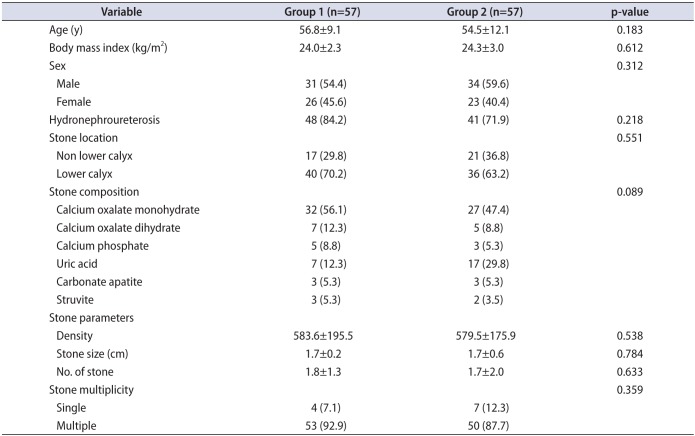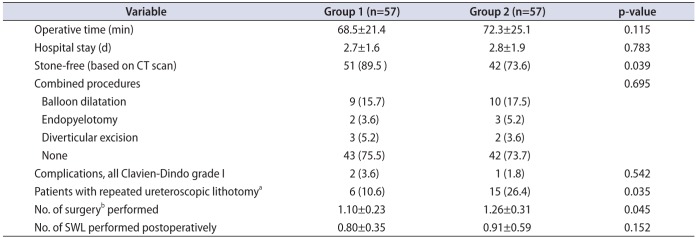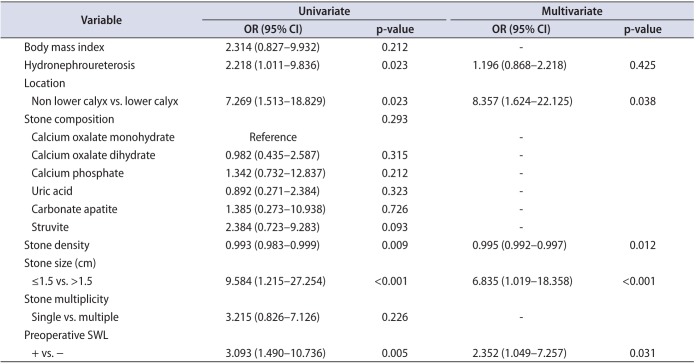1. Traxer O, Dubosq F, Jamali K, Gattegno B, Thibault P. New-generation flexible ureterorenoscopes are more durable than previous ones. Urology. 2006; 68:276–279. PMID:
16904434.

2. Breda A, Ogunyemi O, Leppert JT, Lam JS, Schulam PG. Flexible ureteroscopy and laser lithotripsy for single intrarenal stones 2 cm or greater--is this the new frontier? J Urol. 2008; 179:981–984. PMID:
18207179.

3. Hyams ES, Munver R, Bird VG, Uberoi J, Shah O. Flexible ureterorenoscopy and holmium laser lithotripsy for the management of renal stone burdens that measure 2 to 3 cm: a multi-institutional experience. J Endourol. 2010; 24:1583–1588. PMID:
20629566.
4. Akman T, Binbay M, Ozgor F, Ugurlu M, Tekinarslan E, Kezer C, et al. Comparison of percutaneous nephrolithotomy and retrograde flexible nephrolithotripsy for the management of 2-4 cm stones: a matched-pair analysis. BJU Int. 2012; 109:1384–1389. PMID:
22093679.
5. Michel MS, Trojan L, Rassweiler JJ. Complications in percutaneous nephrolithotomy. Eur Urol. 2007; 51:899–906. PMID:
17095141.

6. de la Rosette J, Assimos D, Desai M, Gutierrez J, Lingeman J, Scarpa R, et al. The Clinical Research Office of the Endourological Society Percutaneous Nephrolithotomy Global Study: indications, complications, and outcomes in 5803 patients. J Endourol. 2011; 25:11–17. PMID:
21247286.
7. Akman T, Binbay M, Ugurlu M, Kaba M, Akcay M, Yazici O, et al. Outcomes of retrograde intrarenal surgery compared with percutaneous nephrolithotomy in elderly patients with moderate-size kidney stones: a matched-pair analysis. J Endourol. 2012; 26:625–629. PMID:
22141372.

8. Chung BI, Aron M, Hegarty NJ, Desai MM. Ureteroscopic versus percutaneous treatment for medium-size (1-2-cm) renal calculi. J Endourol. 2008; 22:343–346. PMID:
18294042.

9. Dindo D, Demartines N, Clavien PA. Classification of surgical complications: a new proposal with evaluation in a cohort of 6336 patients and results of a survey. Ann Surg. 2004; 240:205–213. PMID:
15273542.
10. Stamatelou KK, Francis ME, Jones CA, Nyberg LM, Curhan GC. Time trends in reported prevalence of kidney stones in the United States: 1976-1994. Kidney Int. 2003; 63:1817–1823. PMID:
12675858.
11. Hosseini MM, Hassanpour A, Farzan R, Yousefi A, Afrasiabi MA. Ultrasonography-guided percutaneous nephrolithotomy. J Endourol. 2009; 23:603–607. PMID:
19335156.

12. Osman M, Wendt-Nordahl G, Heger K, Michel MS, Alken P, Knoll T. Percutaneous nephrolithotomy with ultrasonography-guided renal access: experience from over 300 cases. BJU Int. 2005; 96:875–878. PMID:
16153221.

13. Bryniarski P, Paradysz A, Zyczkowski M, Kupilas A, Nowakowski K, Bogacki R. A randomized controlled study to analyze the safety and efficacy of percutaneous nephrolithotripsy and retrograde intrarenal surgery in the management of renal stones more than 2 cm in diameter. J Endourol. 2012; 26:52–57. PMID:
22003819.
14. Skolarikos A, de la Rosette J. Prevention and treatment of complications following percutaneous nephrolithotomy. Curr Opin Urol. 2008; 18:229–234. PMID:
18303550.

15. Breda A, Ogunyemi O, Leppert JT, Schulam PG. Flexible ureteroscopy and laser lithotripsy for multiple unilateral intrarenal stones. Eur Urol. 2009; 55:1190–1196. PMID:
18571315.

16. Johnson GB, Portela D, Grasso M. Advanced ureteroscopy: wireless and sheathless. J Endourol. 2006; 20:552–555. PMID:
16903813.

17. Johnson GB, Grasso M. Exaggerated primary endoscope deflection: initial clinical experience with prototype flexible ureteroscopes. BJU Int. 2004; 93:109–114. PMID:
14678380.

18. Mariani AJ. Combined electrohydraulic and holmium:YAG laser ureteroscopic nephrolithotripsy of large (greater than 4 cm) renal calculi. J Urol. 2007; 177:168–173. PMID:
17162030.

19. Pearle MS, Lingeman JE, Leveillee R, Kuo R, Preminger GM, Nadler RB, et al. Prospective randomized trial comparing shock wave lithotripsy and ureteroscopy for lower pole caliceal calculi 1 cm or less. J Urol. 2008; 179(5 Suppl):S69–S73. PMID:
18405758.

20. Cocuzza M, Colombo JR Jr, Ganpule A, Turna B, Cocuzza A, Dhawan D, et al. Combined retrograde flexible ureteroscopic lithotripsy with holmium YAG laser for renal calculi associated with ipsilateral ureteral stones. J Endourol. 2009; 23:253–257. PMID:
19187015.

21. Perlmutter AE, Talug C, Tarry WF, Zaslau S, Mohseni H, Kandzari SJ. Impact of stone location on success rates of endoscopic lithotripsy for nephrolithiasis. Urology. 2008; 71:214–217. PMID:
18308086.

22. Pan J, Chen Q, Xue W, Chen Y, Xia L, Chen H, et al. RIRS versus mPCNL for single renal stone of 2-3 cm: clinical outcome and cost-effective analysis in Chinese medical setting. Urolithiasis. 2013; 41:73–78. PMID:
23532427.
23. Preminger GM. Management of lower pole renal calculi: shock wave lithotripsy versus percutaneous nephrolithotomy versus flexible ureteroscopy. Urol Res. 2006; 34:108–111. PMID:
16463145.

24. Lim SH, Jeong BC, Seo SI, Jeon SS, Han DH. Treatment outcomes of retrograde intrarenal surgery for renal stones and predictive factors of stone-free. Korean J Urol. 2010; 51:777–782. PMID:
21165199.

25. Fabrizio MD, Behari A, Bagley DH. Ureteroscopic management of intrarenal calculi. J Urol. 1998; 159:1139–1143. PMID:
9507817.

26. Grasso M, Loisides P, Beaghler M, Bagley D. The case for primary endoscopic management of upper urinary tract calculi: I. A critical review of 121 extracorporeal shock-wave lithotripsy failures. Urology. 1995; 45:363–371. PMID:
7879329.

27. Grasso M, Ficazzola M. Retrograde ureteropyeloscopy for lower pole caliceal calculi. J Urol. 1999; 162:1904–1908. PMID:
10569534.








 PDF
PDF ePub
ePub Citation
Citation Print
Print



 XML Download
XML Download